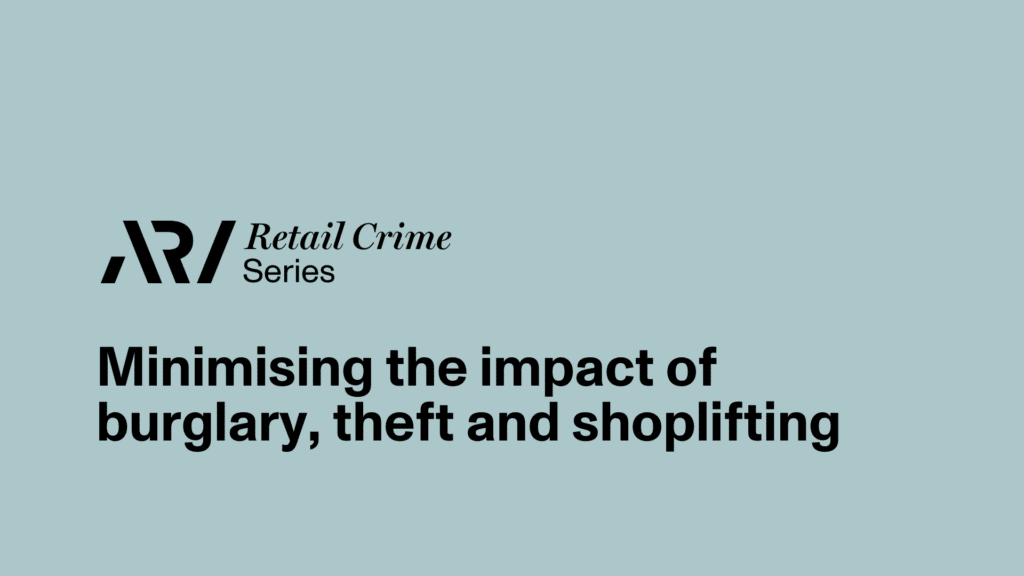Shoplifting and theft costs Australian retailers billions of dollars each year, with the most commonly stolen items being clothing, jewellery, accessories, cosmetics, and tech products.
In this article, the ARA has pulled together some hints and tips for retailers to help reduce the impact of burglary, theft and shoplifting on their business.
Preventing burglary
Securing your premise will make it harder for thieves to enter your shop when it’s closed and minimise property damage in the event that they do break in. You should:
- Maintain a register for keys/ access cards
- Ensure that former employees return their keys/ access card
- Lock keys/ access cards in a secure area when not in use
- Ensure that all doors and windows are secured with deadlocks, including doors to storerooms and backrooms
- Install audible alarms
- Install CCTV
- Use motion-sensor lights at the entrance/ exit to your business
- Ensure that doors are of a solid material and fitted with steel door jamb strengtheners
- Ensure that glass is reinforced with a shatter-resistant film
- Ensure that cash registers and safes are strongly anchored so they cannot be removed easily
- Implement smart cash handling practices.
Preventing shoplifting
A strategic store layout that maximises natural surveillance can disincentivise shoplifters. Some steps you can take include:
- Ensure that your shop is well lit, especially entrances and exits
- Place the sales counter near the exit so that potential thieves have to pass staff when they leave the store
- Elevate the sales counter so that staff have good visibility over the entire store
- Ensure that furniture isn’t blocking staff members’ lines of sight
- Consider using mirrors to increase visibility of dark corners, but make sure they don’t allow customers to see staff handling cash
- Place the most valuable items in the middle of the store or close to the cash register where they can easily be seen by staff
- Consider locking valuable items in cabinets
- Display signs letting customers know about your security measures (e.g. “CCTV in use”, “police will be called if anyone is caught stealing”, “minimal/no cash kept on premises”)
- Consider placing height markers on doors to better judge the height of offenders and allow them to be identified by police.
Having good customer service can deter theft as it lets potential thieves know that staff are aware of their presence and that they are being watched. According to NSW police, shoplifters admit that they look for stores with poor customer service. You should train staff to:
- Greet all customers when they enter your shop or at least make eye contact with them
- Spend time talking to customers and assisting them rather than staying behind the counter
- Avoid turning their backs on customers.
Other in-store investments and practices that improve customer experience can also help prevent shoplifting, for example:
- Implement stock/ inventory counting procedures so that you can identify when items have been stolen as soon as possible
- Ensure employees are aware of the quantity and types of items on the shop floor
- Implement a method of counting the items customers take into dressing rooms
- Ensure that price tags are securely attached to items to make it harder for thieves to swap them
- Consider using RF or RFID tags
- Provide receipts – this way it is harder for a shoplifter to ask for a false refund
- Implement a policy to check backpacks and bags brought in by customers
- Be aware that while you can request to see inside a person’s bag, legally you’re not allowed to search it or touch anything. Customers also have a right to say no if you ask to see inside their bag.
Identifying the signs of shoplifting
It’s important not to stereotype – anyone can be a thief. Common signs of a potential shoplifter include:
- Wearing bulky or seasonally inappropriate clothing (e.g. a coat in warm weather)
- Adjusting clothes, walking awkwardly
- Being erratic or nervous
- Watching staff or the cash register more than they are watching items in the store
- Taking many items into the dressing room and leaving with fewer items
- Entering in a group – shoplifters often enter in a group and stage an organised distraction so that someone can steal while the employees are occupied and not paying attention.
Be aware that shoplifters can also use prams, trolleys, boxes, bags and even umbrellas to conceal stolen items.
Responding to shoplifting
Many businesses prefer to err on the side of caution and instruct their staff not to confront thieves at all. If you witness shoplifting but don’t confront the shoplifter, you should:
- Take note of the time, the offender’s appearance (especially any distinctive features such as scars or tattoos), the direction of departure and, if they leave in a vehicle, the make, model, colour and registration number. Write down your observations as soon as you can.
- Contact the police.
Depending on the circumstances, you may choose to confront non-threatening shoplifters, but staff safety should always come first. In the event that you do confront a shoplifter, you should:
- Make sure this person does not pose a threat to your safety
- Make sure you have actually witnessed them take an item and leave the store without attempting to make a payment
- Take a cooperative approach – be confident but polite
- Have someone accompany you if possible
- Explain who you are and show ID
- Explain why you are confronting them and ask them to come back to the store with you
- Avoid touching the offender.
You could say something like “We believe you have some items with you that have not been paid for. We’d like you to come back to the store with us where we can sort this out.”
If the shoplifter threatens you or refuses to accompany you back to the store, don’t continue to engage with them. Instead, take note of the person’s appearance, speech patterns, and, if applicable, any details about their vehicle including make, model, colour and registration number.
If they do cooperate, once you are back at the store, you should:
- Keep them in your sight
- Ask them to return any stolen items
- Advise them that you will be calling the police.
Keep in mind that you do not have the right to search the shoplifter and that you should always call police to report any incident, even if the offender has left the premises.























